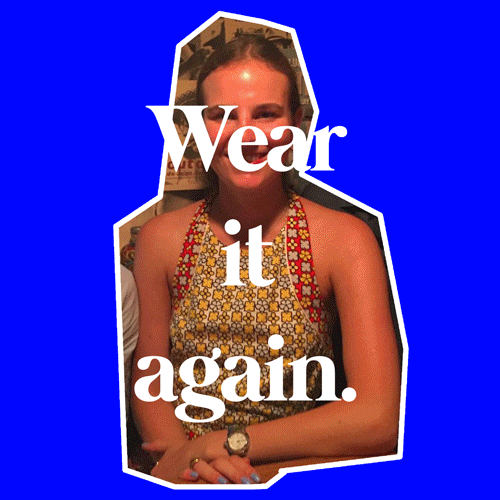In previous articles I discussed how much of the change required to decarbonise the fashion sector will be systemic and led by brands, governments, manufacturers and financial institutions. One crucial element we have not discussed is us, the consumers! We have a key role in making sure this new system works, and making it come about in the first place.
There is a lot we can do to signal to brands that we want the system to change. For many brands, sustainability is not only about ‘doing the right thing’. Like all businesses, they cannot ignore the profitability lens. And this is precisely where us consumers come in. The expression ‘voting with your wallet’ is overused but under- practised. In this article I aim to leave you with some key tips to revolutionise the fashion sector, one wardrobe at a time.
1. Ask questions
The more questions we ask as consumers, the more brands will listen. The more we search for sustainable clothing on search engines or e-commerce platforms, the more brands realise demand exists. Ultimately, fashion brands must make a profit to survive. As they realise their profitability is increasingly tied to consumer demand for sustainability, they will be convinced that going green is both the right and the profitable thing to do. If we don’t ask our favourite brands how their garments are produced, whether they are recyclable or if they come from sustainable sources, the move to a low-carbon circular economy will be slower.
Luckily, there are many brands who are already making this shift. By being inquisitive and finding out which brands align with our environmental concerns, we can support those who are committed to decarbonising and becoming circular. And this will also incentivise brands who aren’t already on this journey to invest in changing their ways.
Ref: A transparent product description, emphasizing the sustainability decision making that went into the development of this product and its final footprint. Click image for a link to allbirds website.
2. Cherish your wardrobe
Dame Vivienne Westwood has provided us with some wise words to live by: “Buy less. Choose well. Make it last.” (Along with creative and sustainable collections!)

Annually, 48 million tonnes of clothing are disposed of, which is estimated to be equivalent to the annual sales volume. 1 This means today we are buying as much clothing every year as we are throwing away. It is clear we cannot ignore the fact that we are buying too much.
We all have garments in our closets that we no longer like, that we’ve only worn once, that haven’t been worn for years, and even some that we may never have worn. What did we think about when we purchased those garments? Did we think how many times we were going to wear them, or what we were going to wear them with? Did we consider their quality, craftsmanship and how they made us feel?
Fashion will always be an incredibly special way to express ourselves. By really thinking about how a beautiful garment we want to buy fits into our closet and how it reflects our personality, we can re-start cherishing our clothing so much that we don’t mind being seen in it multiples times and *GASP!* having several posts of us wearing it on Instagram.
If we cherish what we buy, we want to make it last. This means buying good-quality products and not following all the latest trends just because an influencer told us to. We should only wash clothes when we really need to, so that colours don’t fade and materials don’t degrade. Clothes should also dry naturally, rather than being tossed around in an incredibly energy-intensive dryer. Finally, this also means getting clothes mended, or better yet, learning how to sew ourselves!
If we truly value our clothes and wear them a lot because they are beautiful and they make us feel great, why would we want to immediately discard them and replace them with new ones?
3. Lend, rent and resell

In addition to buying less, buying well and making clothes last, we can also trial new forms of clothing ownership. Many of us already purchase vintage clothing because we like its uniqueness. There is also a flourishing second-hand market on digital platforms for resale, as well as peer-to-peer lending. Some brands are also trialling rental, subscription and repair services.
These new services and ownership models are at the core of the new circular model that will allow the fashion industry to be sustainable.
4. Recycle

Finally, when it is time to part ways with a garment, hopefully after it has been worn (many times), lent, resold and mended, we should recycle it. As discussed in the previous article, textile-recycling infrastructure is currently under-developed. By bringing our clothing back to brands, we are helping them increase their stocks of recyclable material. They need a critical mass of clothing in order to help develop the demand that recycling start-ups need to scale.
Now, time for action!
The time for action is now. We have a decade to avert catastrophic climate change and it is time for consumers to really start voting with their wallets and use their wardrobes as a tool to revolutionise the fashion sector.
In summary, all you have to do is: 1) Ask questions & do your research 2) Buy less, choose well & make it last 3) Be open to new forms of ownership 4) And recycle!
Next week we will be looking at how the sector has been impacted by Covid-19 and how this has provided a space for reflection on the state of fashion for both brands and consumers.
The views expressed in this article are the author's own as an individual.
[1] Ellen MacArthur Foundation, A new textiles economy: Redesigning fashion’s future (2017)

